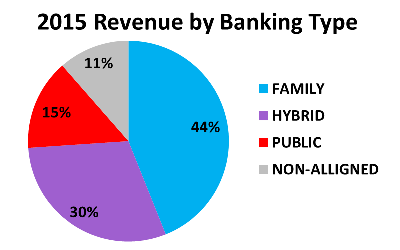You are here
Who Funds Parent's Guide to Cord Blood?
A recent publication1 characterized the web site of our non-profit Foundation as “sponsored by commercial banks”. In order to clarify our operations and put to rest any invalid assumptions, we are voluntarily publishing a breakdown of our sources of financial support during the calendar year 2015, our last complete fiscal year.
We have divided the sources of our 2015 revenue into the following four categories:
- Family – Organizations that are primarily devoted to providing or facilitating private cord blood storage for families.
- Public - Organizations that are primarily devoted to providing or facilitating cord blood donations to public banks.
- Hybrid - Organizations that have substantial activity in both public and private cord blood banking.
- Non-Aligned – All supporters who cannot be categorized as belonging to either the Family or Public camps. This includes all vendors of cord blood banking supplies and all individual donors.
 This pie chart shows the percentages of our Foundation’s 2015 revenue that fell into these four categories. While the biggest single slice of our 2015 revenue is 44% from the Family banking category, it is not our dominant source of support. Overall, in 2015 we received 56% of our support from a combination of sources that promote public banking, or hybrid banking, or are not aligned on this topic.
This pie chart shows the percentages of our Foundation’s 2015 revenue that fell into these four categories. While the biggest single slice of our 2015 revenue is 44% from the Family banking category, it is not our dominant source of support. Overall, in 2015 we received 56% of our support from a combination of sources that promote public banking, or hybrid banking, or are not aligned on this topic.
Parent’s Guide to Cord Blood Foundation has a proven track record of combining income from numerous sources and converting it into cord blood education that is evenly divided between public and private banking models. Over the past year and a half, our Foundation has received support from 65 organizations headquartered in over two dozen countries, demonstrating that we have a broad and international base of support for our mission.
Reference:
- Gregory Katz, Industrial Economics of Cord Blood Banks, Chapter 24 of Cord Blood Stem Cells and Regenerative Medicine, published 2015 Elsevier Academic Press. (see page 338) doi 10.1016/B978-0-12-407785-0.00024-4


